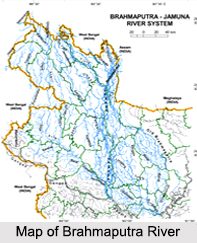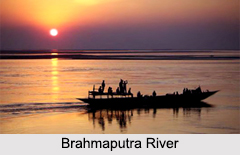 Brahmaputra River is one of the largest rivers in India as well as in Asia. The meaning of the name Brahmaputra in Sanskrit language is `The Son of Brahma`. The river flows in India and its neighboring countries namely, Bangladesh and China. In the Indian subcontinent, it flows through the dense forests and tribal settlements.
Brahmaputra River is one of the largest rivers in India as well as in Asia. The meaning of the name Brahmaputra in Sanskrit language is `The Son of Brahma`. The river flows in India and its neighboring countries namely, Bangladesh and China. In the Indian subcontinent, it flows through the dense forests and tribal settlements.
Geology of Brahmaputra River
Geology of Brahmaputra River relates to the analysis of the minerals and sediments in the Brahmaputra river basin. The river has minerals like kaolinite, illite and chlorite.
Late quaternary sediments of the basin have helped in revealing about the history of Brahmaputra River. Geology of Brahmaputra River also relates to the productive alluvial plains of the river basin.
Geography of Brahmaputra River
Geography of Brahmaputra River relates to the features of the river. Brahmaputra River has a total length of about 3,848 km (2,390 mi). Extensive flood plains and fresh alluvial deposits are associated with the river. During the monsoon season, floods seem to be a widespread occurrence in the geographical area of Brahmaputra River. Excessive deforestation in the Brahmaputra watershed has resulted in increased soil erosion in the habitat located downstream.
Origin of Brahmaputra River
Origin of Brahmaputra River is in the Angsi Glacier in the northern side of Himalayan Mountain in Tibet. The river originates at an elevation of about 5,210 m (17,093 ft). It is known to cut into the valleys of the Himalayas. It passes through the entire Tibetan plateau before entering India.
Course of Brahmaputra River
Course of Brahmaputra River relates to the journey of the river in three nations namely, Tibet, India and Bangladesh. The river is known as Tsang-Po in Tibet, where it flows slowly. Brahmaputra River enters India in the state of Arunachal Pradesh, where it is known as Siang. The river enters Assam and turns very wide. It gets divided into two channels between Dibrugarh district and Lakhimpur district. They are the northern Kherkutia channel and the southern Brahmaputra channel. The two channels meet about 100 km (62 mi) downstream and create the Majuli Island. Brahmaputra River traverses southwest through the Assam valley as Brahmaputra and south through Bangladesh as Jamuna River. The river enters the Bay of Bengal at the Ganges Delta in Bangladesh.
Tributaries of Brahmaputra River
Some of the major tributaries of Brahmaputra River are Sankosh River, Manas River and Dibang River. Other tributaries of the river are Raidak River, Lohit River, Dhansiri River, Kolong River, etc.
Brahmaputra River Basin
Brahmaputra River Basin covers regions of Tibet, China, India and Bangladesh. This basin includes rivers like Lohit River, Burhidihing River, Dihang River, Kameng River, Manas River, Sankh River, Teesta River, Rangeet River, Lachen River, Lachung River and Jaldhaka River.
Transportation in Brahmaputra River
Transportation in Brahmaputra River has improved after the independence of the country. Before independence, Brahmaputra River was utilized as a major waterway in India.















